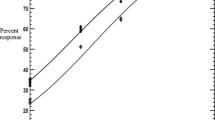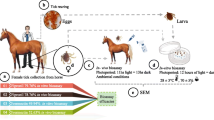Abstract
This study investigated the comparative efficacy of ivermectin and cypermethrin pour-on, for the treatment of Hyalomma anatolicum (a.) anatolicum infestations in bovines. For examining acaricidal efficacy, 480 ticks were exposed in vitro to graded doses of both the acaricides and in vivo efficacy was examined in 360 tick-infested bovines treated at the recommended doses of ivermectin (IVM) and cypermethrin (CYM) pour-on. The comparative quantitative assessment of tick burden was done on days 0, 5, 10, 15, and 20 after treatment using “finger counting.” The results of the tick survival assay indicated both compounds were effective in vitro against H. a. anatolicum. The arc transformed mean surviving ticks, 24 h post immersion, was 2.66 and zero in groups treated with the highest dilutions of IVM and CYM, respectively. At 15 days post-treatment, the CYM pour-on showed a higher in vivo efficacy (no surviving ticks) compared to IVM (mean of 20 surviving ticks). A single dose of CYM and IVM was found effective for 20 and 15 days post-treatment, respectively. Additionally, a questionnaire was used to gather information from 30 small holder dairy farms on the farmer's approach toward the control of ticks. The majority (90%) of respondents were using acaricides incorrectly along with poor husbandry practices on their farms. Overuse of IVM in the tested area of Pakistan may be the reason the IVM is not as effective as expected. These results provide useful tools for the decision making in tick control, as well as providing the basis for testing the findings on provincial and national levels in future studies.



Similar content being viewed by others
References
Ambrose N, Lloyd D, Maillard JC (1999) Immune response to Dermatophilus congolensis infections. Parasitol Today 15:295–300
Bansal GC (2005) Bovine theileriosis in India: an overview. Proc Nat Acad Sci India 75:134–143
Beugnet F, Costa R, Chardonnet L (1994) Adaptations des methods de lutte contre les tiques a l extension du phenomene de chimioresistance: example de Boophilus microplus on Nouvelle-Caledonie Revue. Med Vet 145:931–940
Bianchi MW, Barre N, Messad S (2003) Factors related to cattle infestation level and resistance to acaricides in Boophilus microplus tick populations in New Caledonia. Vet Parasitol 112:75–89
Bittencourt VREP, Massard CL, de Lima AF (1994) Acao do fungo Metarhizium anisopliae em ovos e larvas do carrapato Boophilus microplus. Rev Univ Rural Ser Cienc da Vida 16:41–47
Brossard M (1998) The use of vaccines and genetically resistant animals in tick control. Rev Sci Tech Off Intl Epizoo 17:188–199
Carol JF, Maradufu A, Warthen JD Jr (1989) An extract of Commiphora erythraea, a repellent and toxicant against ticks. Entomol Exp Appl 53:111–116
De Castro ABA, Bittencourt VREP, Daemon E, Viegas EDC (1997) Eficacia do fungo Metarhizium anisopliae sobrre o carrapato Boophilus microplus em teste de estabulo. Rev Univ Rural Ser Cienc da Vida 19:73–82
Dolan TT (1999) Dogma and misunderstanding in East Coast Fever. Trop Med Int Hlth 4:A3–A11
FAO (1984) Acaricidal resistance. Ticks and tick-borne disease control. A practical field manual, vol. 1. Tick control. FAO, Rome, pp 246–299
Fiedler OGH (1958) Control of cattle ticks in South Africa with special reference to the use of ‘Asuntol’ (Bayer 21/199). Vet Med Nach 3:133–146
Foil LD, Coleman P, Eisler M, Fragoso-Sanches H, Garcia-Vasquez Z, Guerrero FD, Jonsson NN, Langstaff IC, Li AY, Machila N, Miller RJ, Morton J, Pruett JH, Torr S (2004) Factors that influence the prevalence of acaricidal resistance and tick-borne diseases. Vet Parasitol 125:163–181
Friesen KJ, Kaufman WR (2003) Cypermethrin inhibits egg development in the ixodid tick, Amblyomma hebraeum. Pest Biochem Physiol 76:25–35
Frisch JE, O'Neill CJ, Kelly MJ (2000) Using genetics to control cattle parasites—the Rockhampton experience. Intl J Parasitol 30:253–264
George JE, Davey RB, Ahrens EH, Pound JM, Drummond RO (1998) Efficacy of amitraz (Taktic® 12.5% EC) as a dip for the control of Boophilus microplus (Canestrini) (Acari: Ixodidae) on cattle. Prev Vet Med 37:55–67
Ghosh S, Azhahianambi P, Furente JDL (2006) Control of ticks of ruminants, with special emphasis on livestock farming systems in India: present and future possibilities for integrated control—a review. Exp Appl Acarol 46:49–66
Gindin G, Samish M, Alekseev E, Glazer I (2001) The susceptibility of Boophilus annulatus (Ixodidae) ticks to entomopathogenic fungi. Biocont Sci Tech 11:111–118
Guerrero FD, Davey RB, Miller RJ (2001) Use of an allele-specific polymerase chain reaction assay to genotype pyrethroid resistant strains of Boophilus microplus (Acari: Ixodidae). J Med Entomol 38:44–50
Hassan SM, Dipeolu OO, Munyinyi DM (1992) Influence of exposure period and management methods on the effectiveness of chickens as predators of ticks infesting cattle. Vet Parasitol 43:301–309
He H, Chen AC, Davey RB, Ivie GW, George JE (1999) Identification of a point mutation in the para-type sodium channel gene from a pyrethroid-resistant cattle tick. Biochem Biophys Res Com 261:558–561
Holdsworth PA, Kemp D, Green P, Peter RJ, De Bruin C, Jonsson NN, Letonja T, Rehbein S, Vercruysse J (2006) World Association for the Advancement of Veterinary Parasitology (WAAVP) guidelines for evaluating the efficacy of acaricides against ticks (Ixodidae) on ruminants. Vet Parasitol 136:29–43
Jamroz RC, Guerrero FD, Pruett JH, Oehler DD, Miller RJ (2000) Molecular and biochemical survey of acaricide resistance mechanisms in larvae from Mexican strains of the sourthern cattle tick, Boophilus microplus. J Insect Physiol 46:685–695
Jongejan F, Uilenberg G (2004) The global importance of ticks. Parasitol 129:S3–S14
Khan MN, Hayat CS, Iqbal Z (1997) Evaluation of acaricidal efficacy of ivermectin, diazinon, permethrin and coumaphos in cattle and buffaloes. Pak Entomol 19:58
Khan MN, Iqbal Z, Hayat CS (1998) Evaluation of acaricidal efficacy of ivermectin, diazinon, permethrin and coumaphos in sheep and goats. Pak J Biol Sci 1:63–65
Knopf L, Komin-Oka C, Betschart B, Jongejan F, Gottstein B, Zinsstag J (2002) Seasonal epidemiology of ticks and aspects of cowardiosis in N'Dama village cattle in Central Guinea savannah of Cote d' Ivoire. Prev Vet Med 53:21–30
Mendes MC, Veríssimo CJ, Kaneto CN, Pereria JR (2001) Bioassays for measuring the acaricides susceptibility of cattle tick Boophilus microplus (canestrini, 1887) in São Paulo state, Brazil. Arq Inst Biol 68:23–27
Miller JA (1987) New approaches to the chemical control of arthropode pests of livestock. Intl J Parasitol 17:689–693
Miller TA (1988) Mechanims of resistance to pyrethroid insecticides. Parasitol Today 4:S10–S11
Mooring MS, McKenzie AA, Hart BL (1996) Grooming in impala: role of oral grooming in removal of ticks and effects of ticks in increasing grooming rate. Physiol Behav 59:965–971
Niyonzema A, Kiltz HH (1986) Control of ticks and tick-borne diseases in Burundi. ACIAR Proc 17:16–17
Norval RAI, Barret JC, Perry BD, Mukhebi AW (1992) Economics, epidemiology and ecology: a multidisciplinary approach to the planning and appraisal of tick and tick-bonre disease control in Southern Africa. In: Fivaz B, Petney T, Horak I (eds) Tick vector biology: The medical and veterinary significance of ticks. Springer, Berlin, pp 35–54
Ogden NH, Swai E, Beauchamp G, Karimuribo E, Fitzpatrick JL, Bryant MJ, Kambarage D, French NP (2005) Risk factors for tick attachment to smallholder dairy cattle in Tanzania. Prev Vet Med 67:157–170
Pegram RG, Oosterwijk GPM (1990) The effect of Amblyomma variegatum on liveweight gain of cattle in Zambia. Med Vet Entomol 4:327–330
Pegram RG, Wilson DD, Hansen JW (2000) Past and present national tick control programs. Why they succeed or fail? Ann NY Acad Sci 916:546–554
Pruett JH (2002) Comparative inhibition kinetics for acetylcholinesterases extracted from organophophate resistant and susceptible strains of Boophilus microplus (Acari: Ixodidae). J Econ Entomol 95:1239–1244
Regassa A (2000) The use of herbal preparations for tick control in western Ethiopia. J S Afr Vet Assoc 71:240–243
Rodriguez M, Penichet ML, Mouris AE, Labarta V, Lorenzo LL, Rubiera R, Cordoves C, Sanchez PA, Ramos E, Soto A, Canales M, Palenzuela D, Triguero A, Lleonart R, Herrera L, De la Fuente J (1995) Control of Boophilus microplus populations in grazing cattle vacccinated with a recobinant Bm86 antigen preparation. Vet Parasitol 57:339–349
Rugg D, Hair JA (2007) Dose determination of a novel formulation of metaflumizone plus amitraz for control of cat fleas (Ctenocephalides felis felis) and brown dog ticks (Rhipicephalus sanguineus) on dogs. Vet Parasitol 150:203–208
Sajid MS, Iqbal Z, Khan MN, Muhammad G, Iqbal MU (2007) Effect of Hyalomma ticks (Acari: Ixodidae) on milk production of dairy buffaloes (Bos Bubalus Bubalis) of Punjab (Pakistan). Italian J Anim Sci 6:939–941
Sajid MS, Iqbal Z, Khan MN, Muhammad G (2008) Point prevalence of hard ticks (Ixodids) infesting domestic ruminants of lower Punjab, Pakistan. Intl J Agric Biol 10:349–351
Samish M, Rehacek J (1999) Pathogens and Predators of ticks and their potential in biological control. Ann Rev Entomol 44:159–182
StatSoft (1999) Statistica for Wndows (Computer program manual). StatSoft, Tulsa
Sutherst RW, Utech KBW (1981) Controlling livestock parasites with host resistnace. In: Pimentel D (ed) CRC handbook of pest management in agriculture, vol 2. CRC, Boca Raton
Sutherst RW, Jones RJ, Schnitzerling HJ (1982) Tropical legumes of the genus Stylosanthes immobilize and kill cattle ticks. Nature 295:320–321
Swai E (2002) Epidemiological studies of tick-borne diseases in small scale dairy farming systems in Tanzania. Ph.D. Thesis, University of Reading
Thrusfield M (1995) Veterinary epidemiology. Blackwell Science, Cambridge, pp 180–181
Willadsen P (1987) Immunological approaches to the control of ticks. Intl J Parasitol 17:671–677
Zerba E (1988) Insecticidal activity of pyrethroides on insects of medical importance. Parasitol Today 4:S8–S9
Acknowledgments
The study is a part of research conducted in an indigenous Ph.D. fellowship scheme funded by the Higher Education Commission of Pakistan. The authors would like to thank Dr. Thomas Nolan, Laboratory of Parasitology, University of Pennsylvania, Philadelphia, for reviewing the manuscript.
Author information
Authors and Affiliations
Corresponding author
Rights and permissions
About this article
Cite this article
Sajid, M.S., Iqbal, Z., Khan, M.N. et al. In vitro and in vivo efficacies of ivermectin and cypermethrin against the cattle tick Hyalomma anatolicum anatolicum (Acari: Ixodidae). Parasitol Res 105, 1133–1138 (2009). https://doi.org/10.1007/s00436-009-1538-2
Received:
Accepted:
Published:
Issue Date:
DOI: https://doi.org/10.1007/s00436-009-1538-2




